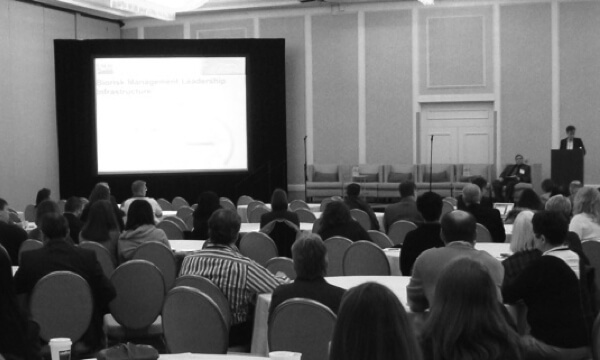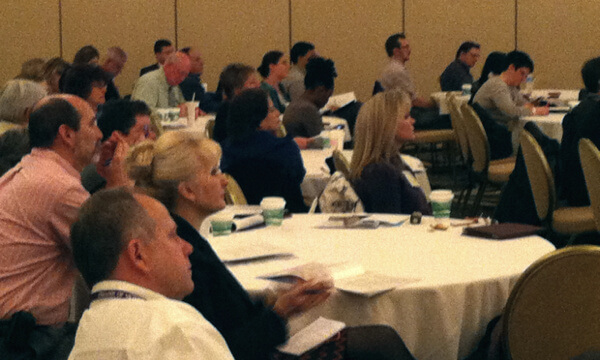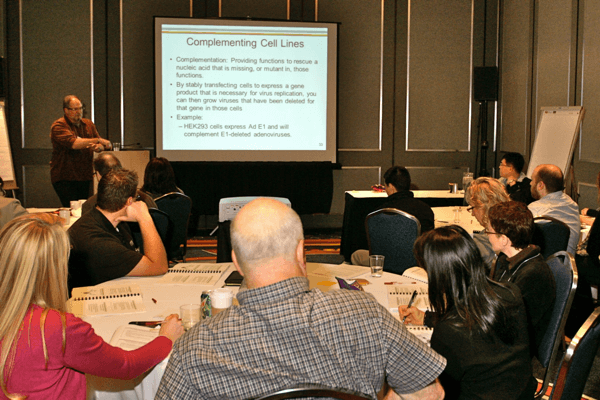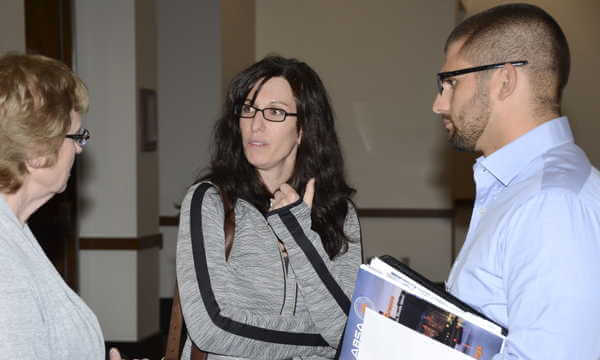Professional Development Courses
In-person Pre-Symposium Professional Development Courses
All in-person courses will be held onsite in Baltimore, Maryland on Monday, February 6, 2023.
8:00 am – 5:00 pm
ARS01. Arthropod Diseases of Veterinary and Zoonotic Concern
Dennis Bente, DVM, PhD, University of Texas Medical Branch—Galveston, Galveston, TX
Barbara Drolet, PhD, USDA—Agricultural Research Service, Manhattan, KS
Massaro Ueti, PhD, DVM, USDA—Agricultural Research Service, Pullman, WA
Bill Wilson, PhD, USDA—National Bio and Agro-Defense Facility, Manhattan, KS
Sarah Ziegler, PhD, RBP(ABSA), CBSP(ABSA), SM(NRCM), Sitero, Manhattan, KS
The goal of the course is to provide biosafety professionals with an overview of arthropod biocontainment, risk assessments, and disease agents. Scientists will give expert information about arthropod-borne diseases. Vectors to be covered include mosquitoes, ticks, and midges. A discussion will be held about field considerations with arthropods. There will be an emphasis on handling and containment considerations, risk assessment considerations, occupational health considerations and decontamination. Hands-on, group activities will give participants a chance to interact with their peers and solve real-world issues.
Objectives:
- Identify common risks associated with arthropod research
- Restate the challenges of working with arthropod diseases and those of agricultural concern
- Identify concepts of arthropod containment
- Summarize common aspects of arthropod vectors of disease
Suggested Background: None
Target Audience: Biosafety Officers and Laboratory Personnel
Audience Level: Intermediate
CONTACT HOURS
This course has been approved for 1.0 CM points toward RBP/CBSP recertification. ABSA International is approved as a provider of continuing education programs in the clinical laboratory sciences by the ASCLS P.A.C.E.® Program. This course is approved for 7.50 P.A.C.E.® contact hours.
8:00 am – 12:00 pm
ARS02. Risks of Deferred Maintenance in High-Containment Facilities
Miguel Grimaldo, DSc, MEng, University of Texas Medical Branch—Galveston, Galveston, TX
John Henneman, MS, RBP(ABSA), Gilbane Building Company, Cleveland, OH
Many biocontainment research facilities have limitations with funding and budgets for maintenance which are often the first to be cut. Sometimes, necessary maintenance needs are postponed or not done at all. This course will discuss ways to sustain maintenance to avoid running equipment to a failure point, options and lessons learned in prioritizing what equipment to fix first, and examples of how value engineering can come back to haunt you. Long-term planning can be a challenge without fixed budget allocations. Information on defining and starting a maintenance plan will be shared, along with suggestions for creating a culture of responsibility and ownership for the maintenance staff. Discussions will include options to consider when creating priorities, knowing the critical equipment, estimating some type of budget, and establishing a facility risk assessment to maintain safe operations.
Objectives:
- Describe the consequences of postponing critical maintenance
- Identify the basic steps in forming a maintenance plan
- Define the critical equipment for your facility
Suggested Background: None
Target Audience: Biosafety Professionals, Facility Managers, Facility Engineers
Audience Level: Basic
CONTACT HOURS
This course has been approved for 0.5 CM points toward RBP/CBSP recertification. ABSA International is approved as a provider of continuing education programs in the clinical laboratory sciences by the ASCLS P.A.C.E.® Program. This course is approved for 3.50 P.A.C.E.® contact hours.
8:00 am – 12:00 pm
ARS03. Welcome to the Biosafety Profession
John Balog, RBP(ABSA), Veterans Administration, Washington, DC
Robert Hawley, PhD, RBP(ABSA)(Ret), CBSP(ABSA)(Ret), Frederick, MD
Joseph Kozlovac, MS, RBP(ABSA), CBSP(ABSA), USDA—Agricultural Research Service, Beltsville, MD
Erin Sorrell, PhD, Elizabeth R. Griffin Program, Georgetown University, Washington, DC
In this course, instructors will describe the expectations for the new biosafety professional in the various sectors where they work by comparing and contrasting the expectations for each respective sector (government, academia, industry). The instructors will discuss how to assess program responsibilities, the importance of knowing one’s strengths and weaknesses, and how to plan one’s professional development to best serve their clientele. A group discussion about perspectives on career building, service to the profession, where and how to network to develop into an asset to one’s colleagues, clients, peers, and supervisor will occur. The course will conclude with a Q&A panel discussion. The panelists are early career biosafety professionals who will share some of their poignant experiences within the profession.
Objectives:
- Discuss how to assess program responsibilities
- Describe the importance of identifying and aligning efforts with the organizational goals and mission
- Create a performance plan and describe how to follow it
Suggested Background: None
Target Audience: New Biosafety Professionals, Recent College Graduates, Early/Mid-Career migration into the field of biosafety
Audience Level: Basic
CONTACT HOURS
This course has been approved for 0.5 CM points toward RBP/CBSP recertification. ABSA International is approved as a provider of continuing education programs in the clinical laboratory sciences by the ASCLS P.A.C.E.® Program. This course is approved for 3.50 P.A.C.E.® contact hours.
1:00 pm – 5:00 pm
ARS04. Biocontainment Facility Design: Systematic Biorisk Management from Ideas to Operation
Miguel Grimaldo, DSc, MEng, University of Texas Medical Branch—Galveston, Galveston, TX
Ellen Joosten, PhD, Merck Sharp Dohme, Boxmeer, The Netherlands
Uwe Mueller-Doblies, MRCVS Dr.med.vet. Dipl. ECVPH, Merck Sharp Dohme, Krems, Austria
Barbara Owen, MPH, RBP(ABSA), CBSP(ABSA), Merck & Co., Inc., Kenilworth, NJ
Biorisk assessments are a central pillar of any biorisk management program and enshrined in international and national biosafety and biorisk management regulations and guidance. The course is presenting and applies tools to support biosafety professionals with the planning, execution, and communication in biosafety facility design projects, including systematic risk assessment and risk-based delivery. The risk assessment tools can be applied when implementing biorisk management systems in new and existing facilities. The course will review the expectations from biorisk assessments and how to meet them with multidisciplinary project teams and operations teams. The course will also apply barrier-based risk management in the implementation of the World Organization for Animal Health/Office International des Epizooties (WOAH/OIE) Terrestrial Manual, Biosafety and Biosecurity: Standard for Managing Biological Risks in the Veterinary Laboratory and Animal Facilities (OIE Terrestrial Manual, Chapter 1.1.4). Instructors have combined over 75 years of experience in biosafety facility management and projects including R&D laboratories, biotech, pharma, high-containment, and animal facilities.
Objectives:
- Recognize and prioritize hazards and risks in complex operations, project front-end loading, and project governance
- Select and apply risk assessment techniques tailored to processes (e.g., task assessment, HazOP, FMEA, Bowtie, LOPA, SWIFT)
- Define key outputs from a risk assessment utilized for project management and facility operation
- Summarize the implementation of the WOAH/OIE terrestrial manual biosafety and biosecurity risk management principles
- Describe lean processes for the delivery of projects with small biosafety teams
- Develop risk communication improvements with stakeholders from other disciplines
Suggested Background: Operational experience in biosafety, biocontainment, and risk management, Risks of Deferred Maintenance in High-Containment Facilities
Target Audience: Individuals with experience in overseeing biorisk management programs, designing biocontainment facilities, and owners of such facilities, who have the ultimate accountability
Audience Level: Intermediate
CONTACT HOURS
This course has been approved for 0.5 CM points toward RBP/CBSP recertification. ABSA International is approved as a provider of continuing education programs in the clinical laboratory sciences by the ASCLS P.A.C.E.® Program. This course is approved for 3.50 P.A.C.E.® contact hours.
1:00 pm – 5:00 pm
ARS05. Life Science Facility Effluent, Carcass, and Solid Waste Decontamination Technologies
Joseph H. Wilson, CEO, Bio-Response Solutions, Inc., Danville, IN
Life Science facilities generate many different categories of waste that must be handled and decontaminated safely before removal from the containment barrier. This course addresses technology details to consider for specifying systems for disposition of these wastes. Specifically, we will cover Effluent Decontamination System technologies in great detail, carcass disposition technologies, and briefly autoclave selection issues. Misapplication of technology for these waste streams has occurred (and still occurs routinely) in the past and has resulted in significant cost to correct. A few examples will be described. Some newer types of systems are being implemented today and will be discussed. Preparation for this is not required, however beneficial, a review of Chapters 8 and 9 (by Paul Langevin and Joseph Wilson {course presenter}) in the ABSA International Anthology of Biosafety Series Volume XIII would give course recipients significant information prior to this course.
Objectives:
- Describe the options available for handling and treatment of different types of wastes
- Summarize all the different types of waste disposal systems, how to properly select and size them, how they compare in acquisition and operational cost, and what infrastructure requirements are necessary for implementation, operation, and ongoing maintenance of these systems and facilities
- State key biosafety considerations in owning, testing, operating, and maintaining the different types of systems including managing and disposition of the end products
Suggested Background: None
Target Audience: Biocontainment Facility Designers, Facility Administrators, Facility Managers, Biosafety Professionals, Animal Facility Personnel, Facility Maintenance Personnel
Audience Level: All Levels
CONTACT HOURS
This course has been approved for 0.5 CM points toward RBP/CBSP recertification. ABSA International is approved as a provider of continuing education programs in the clinical laboratory sciences by the ASCLS P.A.C.E.® Program. This course is approved for 3.50 P.A.C.E.® contact hours.
Virtual Pre-Symposium Professional Development Course
(all virtual courses are in Central Time Zone)
Registration must be completed 1 business day prior to the start of the training.
Registrations received after will receive access to the recording only.
Tuesday, January 31 and Thursday, February 2, 2023, 11:00 am – 3:30 pm CST
ARS1V. Plant Pathology and Containment
Dann Adair, BS, Dann Adair Consulting, North Branch, MN
Deb Howard, MPH, CBSP(ABSA), BASF, Durham, NC
Nina Shishkoff, PhD, USDA—Agricultural Research Service, Fort Detrick, MD
Kirk Martin, DPM, CBSP(ABSA), USDA—Animal Plant Health Inspection Service, Riverdale, MD
James Stack, PhD, Kansas State University, Manhattan, KS
Tim Widmer, PhD, USDA—Agricultural Research Service, Beltsville, MD
The course will provide a background overview and illustration of how containment facilities for plant research can be designed, constructed, and operated to meet various standards and guidelines. The standards will be based on those given by US agencies though international entities will also be referenced. Principles of plant diseases and the organisms that cause them will be discussed as well as an emphasis on the pathways that pathogens may disseminate to new areas and using diagnosis for early and accurate detection. Case studies will be used to give an overview of systems that protect cropping systems from plant diseases. The plant diseases caused by insects section will focus on insect damage and insect disease and on how insects are the most important vectors of plant viruses and the main means of the spread of many plant pathogens. The Animal Plant Health Inspection Service (APHIS) began using a new permitting system in 2021-22 for several USDA programs: Plant Protection Quarantine (PPQ), Biotechnology Regulatory Services (BRS), and Veterinary Services (VS). This section will provide an overview of what to expect when utilizing the new system to apply for imported soil and plant pest and pathogen permits and advise how the phase-out of permits already in its predecessor ePermits will be managed and new features incorporated into eFile will be covered. Another section on decontamination of greenhouses, and solid and liquid waste will occur.
Topics to be covered:
- Design, Construction, and Management of Greenhouses and Related Growth Facilities: An Overview
- Pathogens
- Decontamination
- Arthropod disease in plants
- Biosafety and Permitting (APHIS eFile system)
Objectives:
- Describe the ways insects infect plants and the economic impact
- Apply greenhouse design features to avoid introducing plant diseases into agriculture and the environment
- Restate how to access eFile system to apply for PPQ permits for both new users, and those experienced using the ePermits system
Suggested Background: None
Target Audience: Laboratory or Greenhouse Personnel, Engineers, Regulatory Compliance Staff, BSOs or Greenhouse Facility Managers with various knowledge levels and/or experience in biosafety/biocontainment and/or plant pathology/health
Audience Level: Basic/Intermediate
Course Length: 8 hours (two 4-hour live sessions with a 30-minute break each session)
CONTACT HOURS
This course has been approved for 1.0 CM points toward RBP/CBSP recertification. ABSA International is approved as a provider of continuing education programs in the clinical laboratory sciences by the ASCLS P.A.C.E.® Program. This course is approved for 7.50 P.A.C.E.® contact hours.
The links to the various invitations for the course will be unique to the user and cannot be shared. The links are for single, individual use only. If more than one occurrence of an individual’s name is on the Zoom attendee list or a name not of the roster, all instances will be removed from the webinar with no refund. The webinar and its associated links are for single, individual use only.
Tuesday, February 21, 2023, 11:00 am – 3:30 pm CST
ARS2V. Agricultural Risk Assessment
Nick Chaplinski, MS, RBP(ABSA), USDA—Agricultural Research Service, Athens, GA
Travis McCarthy, PhD, RBP(ABSA), United States Department of Agriculture, Ames, IA
David White, DVM, PhD, RBP(ABSA), DACVM United States Department of Agriculture, Ames, IA
This course will cover critical differences between the “normal” laboratory risk assessment process (as outlined in the Biosafety in Microbiological and Biomedical Laboratories (BMBL)) and the more holistic agricultural risk assessment process that is required to focus on both worker health and safety as well as release to the environment. Biocontainment is a part of all risk assessment processes and it becomes critically important to delineate it as a separate goal of risk mitigation strategies when working with agriculturally important agents, as they are not often highly hazardous to humans. Therefore, these agents are seen as “safe” when, in reality, they present a real threat to the animals and environment surrounding the laboratory. Additionally, the risk of these “safe” agents will be discussed in the context of the emerging/re-emerging agents that are just as likely to be present in veterinary clinical laboratory or necropsy spaces as in human healthcare settings. The focus of the course will be on the critical aspects of agricultural risk assessment that differ from other described processes: the potential economic impact on local or regional animal and plant morbidity and mortality; and the international trade implications of disease presence in the country.
Objectives:
- Conduct risk assessments for working with agricultural agents and/or animals at various levels of biocontainment, including foreign animal (i.e. transboundary) diseases
- Conduct risk assessments for working with zoonotic agricultural agents and/or animals at various levels of biocontainment, including foreign animal (i.e. transboundary) diseases, and focus on Occupational Health issues that may not be present in other assessments
- Develop practices and procedures appropriate for mitigating the risk of working with agriculturally important agents and/or animals infected with various pathogens
- Assess a facility’s ability to contain the agriculturally important agents or animals infected with various pathogens (ABSL1-4Ag)
Suggested Background: Fundamentals of Biosafety, Risk Assessment, Biosafety Level 3-Design an Operations, Principles & Practices of Biosafety
Target Audience: Biosafety Professionals, Animal Caretakers, All Safety Professionals
Audience Level: All levels
Course Length: 4 hours (one 4-hour live session with a 30-minute break)
CONTACT HOURS
This course has been approved for 0.5 CM points toward RBP/CBSP recertification. ABSA International is approved as a provider of continuing education programs in the clinical laboratory sciences by the ASCLS P.A.C.E.® Program. This course is approved for 3.50 P.A.C.E.® contact hours.
The links to the various invitations for the course will be unique to the user and cannot be shared. The links are for single, individual use only. If more than one occurrence of an individual’s name is on the Zoom attendee list or a name not of the roster, all instances will be removed from the webinar with no refund. The webinar and its associated links are for single, individual use only.






